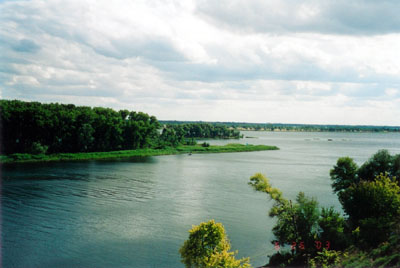JewishGen | KehilaLinks | Colonies of Ukraine | Courland SIG
MapQuest Map | Search JGFF
| All Latvia Database
All Ukraine Database | | Ukraine SIG
Introduction | 1840 History | 1877 Map | 1941 Shoah | 2003 Visit
L'vove, Kherson, Ukraine
1840 - From Courland to Kherson

L'vove rivers Kozak and Dnieper |
At the end of 18th - beginning 19th century the Russian Empire acquired new territories in the Baltic region and Novorossiya (New Russia) in southeast Ukraine. On one hand, the government was anxious to develop Novorossiya; on the other, it was faced with the so-called "Jewish Question" in the Baltics. In an effort to solve both issues, it encouraged Jews to move from the crowded and economically poor centers in the Baltic region to agricultural colonies in Novorossiya. The migration lasted on and off from 1806 to 1845 with mixed results.1 |
|
In 1840 346 families from Courland, mainly from Mitau, Bausk, Hasenpoth and Goldingen migrated to Kherson guberniya.2 "The condition in which most of these colonists from Siberia and from the northwestern governments arrived at South Russia was pitiful. On the road many died, while others had to be placed in hospitals. The Courlanders - destined to be pioneers of colonization - were maltreated by the officials in charge during their voyage down the Dnieper, and were unable to begin work till the following year
For more information visit Colonies of Ukraine, Courland SIG, All Latvia Database, All Ukraine Database and Ukraine SIG. In addition, Latvian Archives may provide specific information on your family.
Records from Kolonie L'vove were located at the Central Archives for the History of Jewish People in Jerusalem. There is a Jewishgen Project to acquire and translate these records.
1 Chaim Freedman, Jewish Agricultural Colonies in the Ukraine, Colonies of Ukraine, JewsishGen.
2 Dr. S. Lipschitz, Jewish Communities in Kurland, Latvia SIG, JewisgGen.
3 Lvov (Lemberg) probably refers to L'vove.
4 Herman Rosenthal, Agricultural Colonies in Russia, Jewish Encyclopedia.
Compiled by Marco Curzon (z"l), Sarah Lee Meyer Christiansen and Dmitry Abrahamson. Updated December 8, 2013. Copyright © 2008 Dmitry Abrahamson and Sarah L. M. Christiansen
|
This website is hosted by JewishGen, Inc. |
 |
JewishGen | KehilaLinks | Colonies of Ukraine | Courland SIG
MapQuest Map | Search JGFF
| All Latvia Database
All Ukraine Database | | Ukraine SIG
Introduction | 1840 History | 1877 Map | 1941 Shoah | 2003 Visit